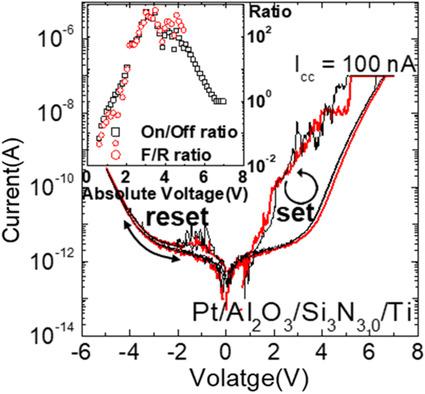当前位置:
X-MOL 学术
›
Phys. Status Solidi. Rapid Res. Lett.
›
论文详情
Our official English website, www.x-mol.net, welcomes your
feedback! (Note: you will need to create a separate account there.)
Area‐Type Electronic Bipolar Resistive Switching of Pt/Al2O3/Si3N3.0/Ti with Forming‐Free, Self‐Rectification, and Nonlinear Characteristics
Physica Status Solidi-Rapid Research Letters ( IF 2.5 ) Pub Date : 2020-06-03 , DOI: 10.1002/pssr.202000209 Dae Eun Kwon 1 , Jihun Kim 1 , Young Jae Kwon 1 , Kyung Seok Woo 1 , Jung Ho Yoon 2 , Cheol Seong Hwang 1
Physica Status Solidi-Rapid Research Letters ( IF 2.5 ) Pub Date : 2020-06-03 , DOI: 10.1002/pssr.202000209 Dae Eun Kwon 1 , Jihun Kim 1 , Young Jae Kwon 1 , Kyung Seok Woo 1 , Jung Ho Yoon 2 , Cheol Seong Hwang 1
Affiliation

|
Herein, electronic bipolar resistive switching of Pt/Al2O3/Si3N3.0/Ti device is investigated. The Pt/Si3N3.0/Ti device demonstrates bipolar resistive switching with set (reset) at negative (positive) bias, and the mechanism is revealed to be that the conduction filament, formed by percolation of the traps in defective silicon nitride thin film, is involved in the resistive switching. However, instead of the conduction filament, trapping and detrapping of the electrons in the trap sites of Si3N3.0 become the dominant switching mechanism by introducing an Al2O3 barrier layer between Pt and Si3N3.0, and the device has forming‐free, self‐rectifying, and nonlinear characteristics, which are necessary to the cross‐bar array (CBA) configuration. The optimized thickness of the Al2O3 barrier layer is 4 nm. A detailed electrical analysis is performed to identify the switching mechanism of the device. Also, the read/write margin is calculated using H simulation program with integrated circuit emphasis (HSPICE) to estimate the available CBA cell size.
中文翻译:

具有无变形,自整流和非线性特性的Pt / Al2O3 / Si3N3.0 / Ti区域类型电子双极电阻开关
在此,研究了Pt / Al 2 O 3 / Si 3 N 3.0 / Ti器件的电子双极电阻切换。Pt / Si 3 N 3.0 / Ti器件演示了双极性电阻开关,其设置(复位)处于负(正)偏压,并且该机理被揭示为由缺陷氮化硅薄膜中陷阱的渗滤形成的导电丝,参与电阻切换。然而,通过引入Al 2 O 3,代替导电丝,Si 3 N 3.0的俘获位点中电子的俘获和去俘获成为主要的开关机制。Pt和Si 3 N 3.0之间的势垒层,并且该器件具有无成形,自整流和非线性特性,这是交叉开关阵列(CBA)配置所必需的。Al 2 O 3阻挡层的最优化厚度为4nm。执行详细的电气分析以识别设备的开关机制。同样,使用具有集成电路重点(HSPICE)的H模拟程序来计算读/写裕量,以估计可用的CBA单元大小。
更新日期:2020-06-03
中文翻译:

具有无变形,自整流和非线性特性的Pt / Al2O3 / Si3N3.0 / Ti区域类型电子双极电阻开关
在此,研究了Pt / Al 2 O 3 / Si 3 N 3.0 / Ti器件的电子双极电阻切换。Pt / Si 3 N 3.0 / Ti器件演示了双极性电阻开关,其设置(复位)处于负(正)偏压,并且该机理被揭示为由缺陷氮化硅薄膜中陷阱的渗滤形成的导电丝,参与电阻切换。然而,通过引入Al 2 O 3,代替导电丝,Si 3 N 3.0的俘获位点中电子的俘获和去俘获成为主要的开关机制。Pt和Si 3 N 3.0之间的势垒层,并且该器件具有无成形,自整流和非线性特性,这是交叉开关阵列(CBA)配置所必需的。Al 2 O 3阻挡层的最优化厚度为4nm。执行详细的电气分析以识别设备的开关机制。同样,使用具有集成电路重点(HSPICE)的H模拟程序来计算读/写裕量,以估计可用的CBA单元大小。











































 京公网安备 11010802027423号
京公网安备 11010802027423号